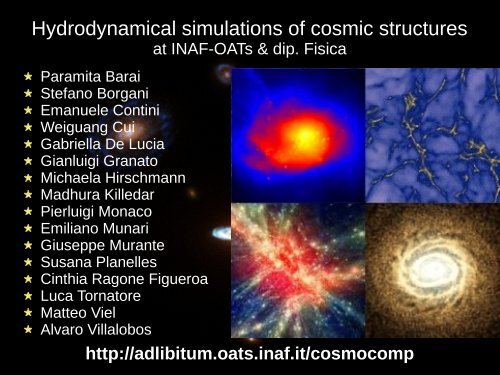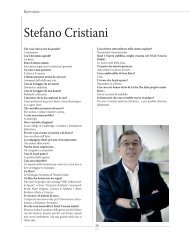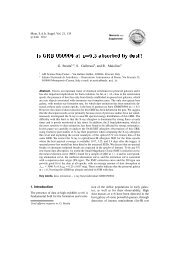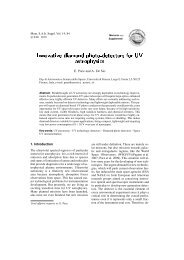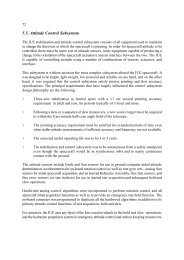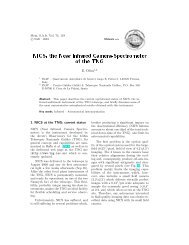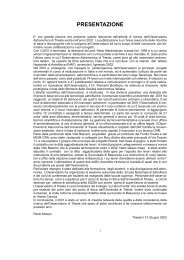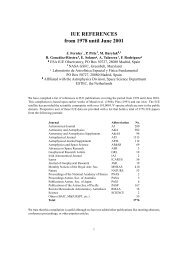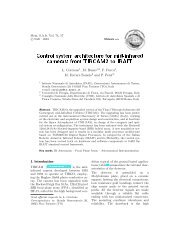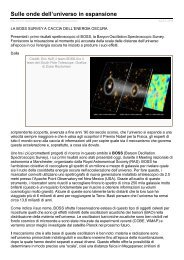Hydrodynamical simulations of cosmic structures
Hydrodynamical simulations of cosmic structures
Hydrodynamical simulations of cosmic structures
You also want an ePaper? Increase the reach of your titles
YUMPU automatically turns print PDFs into web optimized ePapers that Google loves.
<strong>Hydrodynamical</strong> <strong>simulations</strong> <strong>of</strong> <strong>cosmic</strong> <strong>structures</strong><br />
at INAF-OATs & dip. Fisica<br />
Paramita Barai<br />
Stefano Borgani<br />
Emanuele Contini<br />
Weiguang Cui<br />
Gabriella De Lucia<br />
Gianluigi Granato<br />
Michaela Hirschmann<br />
Madhura Killedar<br />
Pierluigi Monaco<br />
Emiliano Munari<br />
Giuseppe Murante<br />
Susana Planelles<br />
Cinthia Ragone Figueroa<br />
Luca Tornatore<br />
Matteo Viel<br />
Alvaro Villalobos<br />
http://adlibitum.oats.inaf.it/cosmocomp
Members <strong>of</strong> the CosmoComp ITN:<br />
An FP7 Initial Training Network for<br />
Computational Cosmology<br />
http://www.cosmocomp.dur.ac.uk/<br />
CosmoComp fellows in Trieste:<br />
Weiguang Cui, Madhura Killedar and Susana Planelles<br />
CosmoComp Nodes: Durham (C. Baugh), CONICET (P. Tissera),<br />
Leiden (J. Schaye), MPA (S. White), Nottingham (F. Pearce), Saclay<br />
(R. Teyssier), Shanghai (Y.P. Jing), Sussex (P. Thomas), Trieste (S.<br />
Borgani)<br />
CosmoComp General Meeting (Trieste – September 4th-7th, 2012)<br />
http://adlibitum.oats.inaf.it/meetings/COSMOCOMPTS/
GADGET-3 by V. Springel<br />
●<br />
●<br />
●<br />
Tools<br />
Tree code to solve gravity + PM at large scales<br />
SPH hydro with energy and entropy conserving formulation<br />
refined load balance to work for isolated objects<br />
chemical evolution code<br />
●<br />
●<br />
enrichment <strong>of</strong> several chemical species by SNII, SNIa and AGB<br />
metal cooling <strong>of</strong> gas by interpolating Cloudy tables<br />
AGN feedback<br />
●<br />
heating from accreting massive black holes<br />
Energy-driven and momentum-driven winds<br />
●<br />
standard and improved implementations<br />
MUlti-Phase Particle Integrator<br />
●<br />
star formation and SN feedback<br />
Zoomed-in initial conditions generator<br />
Molecular chemistry and cooling below 10 4 K<br />
Magnetic fields in clusters<br />
WISH LIST: autonomy on initial conditions, radiative transfer...
collapse<br />
Cosmology (ΛCDM)<br />
gravitational<br />
Dark matter<br />
Galaxies<br />
astrophysics
The big questions<br />
We use hydrodynamical codes and cosmological initial conditions<br />
to simulate the formation <strong>of</strong>:<br />
galaxy clusters and their intra-cluster medium,<br />
the inter-galactic medium,<br />
galaxies in various environments.<br />
How do galaxy formation processes impact on observational<br />
properties <strong>of</strong> clusters?<br />
Can we produce realistic disc galaxies? can we produce realistic<br />
galaxy populations?<br />
Do we understand inflows and outflows <strong>of</strong> baryons?<br />
Do <strong>simulations</strong> and semi-analytic models give a consistent picture<br />
<strong>of</strong> galaxy formation?<br />
How confident are we on the reliability <strong>of</strong> the adopted numerical<br />
hydro schemes?
Simulating<br />
galaxy clusters<br />
zoomed-in initial conditions<br />
Cluster astrophysics:<br />
Thermo- and chemodynamical<br />
properties <strong>of</strong> the ICM<br />
Properties <strong>of</strong> cluster galaxies<br />
Properties and detectability<br />
<strong>of</strong> diffuse intra-cluster light<br />
How do galaxy formation<br />
processes impact on observational<br />
properties <strong>of</strong> clusters?<br />
Fabjan et al. (2010)
galaxy clusters<br />
4<br />
Simulating<br />
Map <strong>of</strong> diffuse intra-cluster light<br />
(Cui et al. in preparation)<br />
Simulation <strong>of</strong> cluster<br />
shocks with Eulierian code<br />
(Planelles et al. submitted)<br />
Maps <strong>of</strong> metal enrichment<br />
for different baryon physics<br />
(Fabjan et al. 2010)<br />
-> observations<br />
<strong>of</strong> clusters<br />
(Tozzi's talk )<br />
-> cluster<br />
cosmology<br />
(Viel's talk)
Simulating galaxy clusters<br />
cosmological boxes<br />
Role <strong>of</strong> feedback for:<br />
• Physics <strong>of</strong> galaxy<br />
formation<br />
• IGM properties at<br />
low and high-z<br />
• Properties <strong>of</strong> the<br />
ICM<br />
Multi-million CPUh projects granted through DEISA, Gauss and<br />
ISCRA, using SP6 and BlueGene/P (PIs: K. Dolag & S. Borgani)
Simulating galaxies<br />
Galaxy astrophysics:<br />
Sub-resolution<br />
star formation and<br />
SN feedback<br />
Properties <strong>of</strong><br />
galaxies: size,<br />
morphology, gas<br />
fraction, bar, Tully-<br />
Fisher, Schmidt-<br />
Kennicutt<br />
Baryon fraction<br />
in DM halos<br />
Can we produce<br />
realistic spiral<br />
galaxies?<br />
Murante et al., in prep.
Scannapieco et al. (2012)
Zoom-in <strong>simulations</strong> <strong>of</strong> 45 individual halos (5e10-2e13M⊙)<br />
Hirschmann et al. in preparation<br />
Can we produce<br />
realistic galaxy<br />
populations?<br />
Ongoing project: simulation <strong>of</strong> 36 Mpc/h box with 512 3 gas + 512 3 DM particles and<br />
128 outputs, with several star formation & SN feedback models, granted by<br />
CASPUR and proposed to CINECA (PI: Murante & Monaco)<br />
-> chemical evolution (De Lucia's talk)<br />
-> SED synthesis (De Lucia's talk)<br />
-> observations <strong>of</strong> galaxies (Tozzi's talk)
Simulating the IGM<br />
IGM astrophysics:<br />
Statistics <strong>of</strong> Lyman-alpha<br />
forest<br />
Thermal and chemical<br />
properties <strong>of</strong> the IGM<br />
Role <strong>of</strong> galaxy outflows and<br />
their detectability as metal<br />
absorbers<br />
-> IGM (D'Odorico's talk)<br />
-> Cosmology with Lymanalpha<br />
forest (Viel's talk)<br />
Do we understand inflows<br />
and outflows <strong>of</strong> baryons?
Log Temperature Projection <strong>of</strong> (200/h kpc)3 volume<br />
around a massive group (3 x 10 12 M ) center (run RVWa, z = 1.98)<br />
(Barai et al. in prep.)
Comparison with semi-analytic<br />
models: cooling<br />
Saro et al. (2010)<br />
Viola et al. (2008)<br />
-> SAM comparison<br />
project (De Lucia)<br />
Do <strong>simulations</strong> and semi-analytic models give<br />
a consistent picture <strong>of</strong> galaxy formation?<br />
Ongoing project: simulation <strong>of</strong> 36 Mpc/h box with 512 3 gas + 512 3 DM particles and<br />
128 outputs, only cooling <strong>of</strong> primordial gas, to be compared with down-stripped<br />
SAM predictions at the object-by-object level, granted by CINECA (PI: Monaco)
Extending SPH: Godunov-SPH<br />
How confident are we on the reliability <strong>of</strong><br />
the adopted numerical hydro schemes?<br />
Murante et al. (2011)
Computers<br />
Supercomputing time obtained<br />
through grants at CINECA<br />
(ISCRA + UniTS), CASPUR,<br />
PRACE...<br />
In-house post-processing<br />
analyses (with lapoderosa, 16-<br />
processor shared memory<br />
DELL machine with 128 Gb <strong>of</strong><br />
RAM)<br />
Moving to the Blue Gene era...<br />
Fermi Blue Gene/Q @ CINECA


